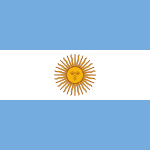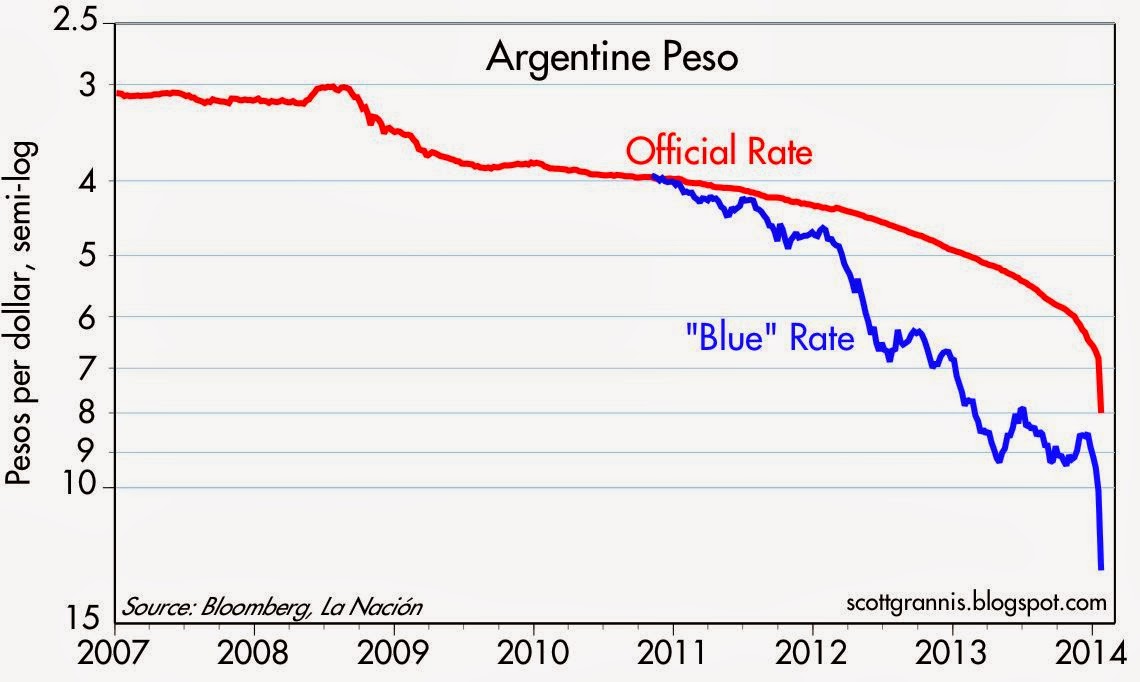With international reserves in virtual free-fall, the black market peso rate plunging, and no sign for months that President Kirchner has any appreciation at all of the gravity of the situation, the country is in the advanced stages of another financial panic/meltdown. This will end badly, another chapter in the long history of Argentine financial crises extending back almost 100 years.
President Kirchner has any appreciation at all of the gravity of the situation, the country is in the advanced stages of another financial panic/meltdown. This will end badly, another chapter in the long history of Argentine financial crises extending back almost 100 years.
So says Scott Grannis (scottgrannis.blogspot.ca) in edited excerpts from his original article* entitled Another Argentine meltdown.
[The following is presented by Lorimer Wilson, editor of www.munKNEE.com and may have been edited ([ ]), abridged (…) and/or reformatted (some sub-titles and bold/italics emphases) for the sake of clarity and brevity to ensure a fast and easy read. This paragraph must be included in any article re-posting to avoid copyright infringement.]
Grannis goes on to say in further edited excerpts:
For real time Argentine inflation figures go HERE
[To the chagrin of the fellow in the following joke entitled “An Argentine Pervert”, the relative worthlessness of the Argentine peso is widely know. The story goes like this:- An Argentine goes to a cabaret/cat house in neighbouring Montevideo, Uruguay.
- The Mama-san introduces him to a girl.
- The customer whispers on the girl’s ear what he wants to do and the girl yells: “You’ve got to be kidding! Get LOST!!”
- Another girl is called and she swears at the customer: “No _ _ _ _ _ _ _ way! Are you crazy?” and runs away.
- The Mama-san intervenes saying, “We have all sort of perverts visiting here, but have never had a problem. What did you ask from the girls?”
- He answers: “Nothing much …. I just want to pay in Argentine pesos.”]
Argentines began to realize in 2011 that the official exchange rate was artificially high, and thus began the capital flight that has drained the government’s international reserves by almost 50% in the past three years. (The artificially strong peso peg forces the government to sell dollars in the face of an overwhelming demand on the part of the public to buy dollars.)
The government has of course tried to stem the capital flight by imposing exchange controls and import controls, but that has only exacerbated the problem. When it comes to confidence, the owners of capital want to know that they are free to leave if problems develop. If they begin to perceive that investing in a country is like a “roach motel” (i.e., you can put your money in, but you can’t get it out), then capital will find no end of ways to circumvent a government’s attempt to keep capital within its borders.
For the past few years, Argentines have been flocking to the U.S. to spend as much as possible with their credit cards, because in this manner they can effectively buy dollars at the official rate plus a 20% “surcharge” imposed by the government to discourage this practice but that’s better than buying dollars on the black market, where they would have to pay 50-70% more. We had some Argentine friends with us several months ago, and they wanted to stop at every ATM they saw, where they would then withdraw as many dollars as the machine would let them. After buying copious amounts of clothes and electronic goodies, they then sold the dollars they took back with them to Argentina on the black market, and easily paid for the cost of their trip. This is how dollars are fleeing Argentina these days.
In 1916, one U.S. dollar was worth two Argentine pesos. Since then, there have been a four major re-denominations of the peso (in which multiple zeros were erased from its value). If the original peso were still in circulation, one U.S. dollar would be worth about 70 trillion pesos at the current official rate, and 120 trillion at the current black market rate.
Interestingly, the Argentine stock market (in peso terms) has almost tripled in the past two years, even as economic growth has slowed dramatically and inflation has risen to 30-35% per year. But in dollar terms, Argentine stocks have registered virtually no gain at all since 1992, when the peso was pegged at 1 to 1 to the dollar and stayed that way for a decade. I take this to be evidence that stocks can be a decent hedge against inflation over time, but not much more.
It’s time to cry once more for Argentina.
UPDATE: The decline of the peso accelerated today as the central bank apparently made no effort to prop up the peso with dollar sales. The dollar briefly hit 8.2 pesos, and is now trading just under 8. This marks a surge in the dollar’s value against the peso of almost 60% since the beginning of last year, and that in turn points to a 60% rise in Argentina’s general price level over the next year or so. That further implies a doubling of Argentina’s inflation rate.
UPDATE 2: The government-imposed “surcharge” on credit card purchases outside the country is now 35%. Band-aid solutions such as this only make things worse, as they effectively move the country closer and closer to a mega-devaluation, which in turn brings higher inflation and more money-printing, in what ends up being a vicious cycle that ends only when the government abandons all attempts to impose “order” on the economy and allows the free market to work its magic. We’re not there yet.
Conclusion
At this point the central bank has little choice but to announce either a significant devaluation of the official rate or a float of the currency but the underlying problem—too much government spending financed by printing money—will remain. Only a radical change in government policies can restore order to the Argentine economy, and that is unlikely as long as President Kirchner remains in control. It’s time for the grownups to take charge.
[Editor’s Note: The author’s views and conclusions in the above article are unaltered and no personal comments have been included to maintain the integrity of the original post. Furthermore, the views, conclusions and any recommendations offered in this article are not to be construed as an endorsement of such by the editor.]
*http://scottgrannis.blogspot.ca/2014/01/another-argentine-meltdown.html?utm_source=feedburner&utm_medium=email&utm_campaign=Feed:+blogspot/tMBeq+(Calafia+Beach+Pundit)
Related Articles:
Like health, freedom erodes gradually over time… then all at once. We lose a freedom here, there, through a slow, measured deterioration of civil and economic liberty: body scanners at the airport; declarations of foreign accounts; mandatory health insurance and then, suddenly, there’s a bifurcation point when the deterioration goes nonlinear. It’s like the old saying about going broke– it happens gradually, then all at once. We lose our freedoms in the same way. [That is already happening in Argentina where the government is] screwing everyone, big time: banks, businesses, workers, retirees, professionals, entrepreneurs, even government employees and the U.S. is starting to go down this road as well. [Let me explain.] Words: 625 Read More »
One can barely keep up with what is going on here in Argentina, since each day brings more ‘new’ government dictates, rules and initiatives which all seem to share the same features – dumb and dumber – and virtually all with guaranteed unintended negative consequences. Let me give you my on-the-ground insights of the lay of the land – of what is REALLY happening in Argentina – and about to happen! Words: 853 Read More »
3. These 21 Countries Have Experienced Hyperinflation In Last 25 Years
Hyperinflation is not an unusual phenomenon. 32 countries have experienced hyperinflation over the last 100 years of which no less than 21 have experienced it in the past 25 years and 3 in the past 10 years. The United States is one of the few countries to have experienced two currency collapses during its history (1812-1814 and 1861-1865). Could it happen again? Words: 1450 Read More
4. The Currency War: Which Country Will End Up With the Fastest Currency in the Race to the Bottom?
We believe that we are in the “competitive devaluation” stage presently [see graph below] as country after country is printing money in order to lower rates and doing whatever possible to devalue their currency – to have the fastest currency in the…race to the bottom – in order to export their goods and services. [The next stage will be protectionism and tariffs. This article gives an update on the race to debase.] Read More »
5. Real-time Inflation Data is Now Available – Finally
Inflation is a significant measurement for the economic health of countries around the world but rates are often reported weeks after data is collected. To address this problem, two professors at MIT Sloan School of Management have launched the Billion Prices Project which is the first website to publish daily price indexes and provide real-time inflation estimates around the world. Words: 825
 munKNEE.com Your Key to Making Money
munKNEE.com Your Key to Making Money



